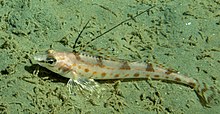Zaniolepis, the combfishes, is a genus of marine ray-finned fish, it is one of two genera in the family Zaniolepididae. These fishes are native to the eastern Pacific Ocean. Z. frenata that was a source of food to the Native American inhabitants of San Nicolas Island off the coast of southern California, United States during the Middle Holocene.[5]
| Zaniolepis Temporal range: Pleistocene to Present[1] | |
|---|---|
 | |
| Longspine Combfish (Z. latipinnis) | |
| Scientific classification | |
| Domain: | Eukaryota |
| Kingdom: | Animalia |
| Phylum: | Chordata |
| Class: | Actinopterygii |
| Order: | Perciformes |
| Superfamily: | Zaniolepidoidea Shinohara, 1994[2] |
| Family: | Zaniolepididae Jordan & Gilbert, 1883 |
| Subfamily: | Zaniolepidinae Jordan & Gilbert, 1883[3] |
| Genus: | Zaniolepis Girard, 1858 |
| Type species | |
| Zaniolepis latipinnis Girard, 1858[4] | |
| Synonyms[4] | |
| |
Taxonomy
Zaniolepis was first proposed as a monospecific genus in 1858 by the French zoologist Charles Frédéric Girard when he described Z. longispinis from Fort Steilacoom on Puget Sound in Washington.[6] This genus is one of two genera in the family Zaniolepidae, each of which is classified within a monotypic subfamily.[7] The subfamily Zaniolepinae, along with the Oxylebiinae, haves been classified as two subfamilies in the Hexagrammidae.[2]
Etymology
Zaniolepis is a combination of xanion, which is a Greek word for a comb used to card wool, and lepis, meaning "scale", referring to the overlapping, almost ctenoid scales of Z. latipinnis.[8]
Species
The currently recognized species in this genus are:[9]
| Image | Scientific name | Common Name | Distribution |
|---|---|---|---|
| Zaniolepis frenata C. H. Eigenmann & R. S. Eigenmann, 1889 | shortspine combfish | Pacific Ocean southern Oregon, USA to central Baja California, Mexico. | |
 | Zaniolepis latipinnis Girard, 1858 | longspine combfish | northeast Pacific Ocean |
Characteristics
Zaniolepis combfishes have a deep incision in the rear third their dorsal fin and the first 3 spines in the dorsal fin are highly elongated, extremely so in Z. latipinnis. The anal fin contains 3 spines while the first 2 rays in the pelvic fins are long and robust and extend past the origin of the anal fin. The caudal fin truncated.[7] These fishes reach a maximum length of 25 cm (9.8 in).[9]
Distribution and habitat
Zaniolepis combfishes are found in the eastern North Pacific Ocean from Alaska to Baja California. They are benthic fishes.[9]
References
Wikiwand in your browser!
Seamless Wikipedia browsing. On steroids.
Every time you click a link to Wikipedia, Wiktionary or Wikiquote in your browser's search results, it will show the modern Wikiwand interface.
Wikiwand extension is a five stars, simple, with minimum permission required to keep your browsing private, safe and transparent.
